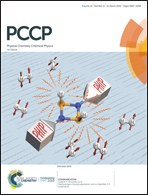Solvent organization around the noncanonical part of tyrosine modulates its fluorescence properties†
Abstract
Noncanonical amino acids are important molecules that enhance the functionality of proteins, and they are also intensively used in therapeutics. In this paper, we have investigated the fluorescence properties of the noncanonical amino acid 2-(trifluoromethyl) tyrosine (TFTyr) in three different alcohols, namely ethanol (ETH), monofluoroethanol (MFE), and trifluoroethanol (TFE), using spectroscopy, quantum chemical calculations and MD simulations. Further, we have compared its fluorescence properties with those of its canonical derivative tyrosine (Tyr) in the same solvents to understand the role of the noncanonical –CF3 group in the fluorescence properties of TFTyr. The excited state lifetime of Tyr decreases monotonically with the fluorination of ETH, whereas the trend is opposite in the case of TFTyr. The calculated emission maxima of different-sized clusters of TFTyr and TFE, as well as comparison with the experimental values, suggest that the role of F⋯F, O–H⋯O and N–H⋯O interactions is significant. Quantum chemical calculations as well as MD simulations suggest that alcohols have a preferred orientation around the noncanonical –CF3 group of TFTyr and the fluorescence properties of TFTyr are very sensitive to the mode of interaction of the –CF3 group of TFTyr with alcohols. This study suggests that TFTyr can be a potential candidate for exploring the role of solvent environments in several biological processes.



 Please wait while we load your content...
Please wait while we load your content...